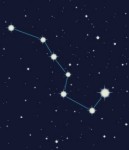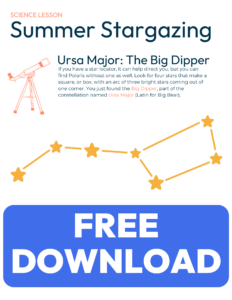There are few things more glorious than viewing the night sky on a clear day, away from the lights of cities. Summer is the perfect time to go stargazing! With this short guide you will learn what to look for this summer as well as get a few general astronomy tips.
Finding the North Star
Constellations are groups of stars that form patterns in the sky that look like animals or people. Many of these patterns have been named after figures in Greek mythology. Finding two main constellations will lead you to Polaris (also called the North Star, because it is aligned with the magnetic north pole), which serves as a compass in the night sky, showing you which way north is year round.
 If you have a star locator, it can help direct you, but you can find Polaris without one as well. Look for four stars that make a square, or box, with an arc of three bright stars coming out of one corner. You just found the Big Dipper, part of the constellation named Ursa Major (Latin for Big Bear).
If you have a star locator, it can help direct you, but you can find Polaris without one as well. Look for four stars that make a square, or box, with an arc of three bright stars coming out of one corner. You just found the Big Dipper, part of the constellation named Ursa Major (Latin for Big Bear).- At the side of the dipper opposite of the handle, there are two bright stars. Follow the line these stars make to Polaris, a star of about the same magnitude, or brightness. Polaris is on the end of the handle of the Little Dipper (part of the constellation Ursa Minor, or Little Bear). Now that you know which direction is north, it will be easier to navigate the night sky.
Planets
The brightest planets can be seen easily with the naked eye; Venus and Jupiter are the easiest to spot in the summer.
If you’re not sure whether it’s a planet or a star, there is a simple way to find out. Fix your gaze on one point of light. If it seems to glimmer or flash, it is a star. Planets will shine with a more steady, even glow than stars do. Another way to tell is by monitoring the sky for several nights in a row. Stars will appear to circulate, but stay the same distance apart from each other, whereas planets appear to move independently, with no fixed relation to the stars or other planets.
Meteor Showers
If you would like to watch part of a meteor shower this summer, the best dates are in mid-August. Every year in late summer, a meteor shower appears close to the constellation Perseus. These impressive meteors, called the Perseids, can appear at a rate of 120 per hour (that means two meteors every minute). The less moonlight there is, the better it is to see the meteors, or “shooting stars.” If you can, try to view the meteors early in the morning, while it is dark. Look for the Perseids in the northeast part of the sky.
To watch a meteor shower, be prepared to spend a few hours sitting outside! Meteor showers can be seen as soon as it gets dark, but optimal viewing begins about 11pm. You will want to go some place far away from large cities, because light pollution makes it impossible to see the night sky clearly. Give your eyes 20 minutes to adjust to the dark before gazing towards the corner of the sky where the meteor shower is expected to appear. You may want to use binoculars, but they are not necessary. While you’re outdoors, you may also want to look for constellations, stars, or planets using a star locator or guide book.
The Summer Triangle
If you have a telescope, find the Summer Triangle, which can help you locate other night sky sights. The two stars by the handle of the Big Dipper will lead you to the Summer Triangle. Trace a line through the stars until you reach a very bright star, Vega. The star locator can also help you locate Vega, one of the brightest stars in the summer sky. To the left is another bright star, Deneb. Look below both stars and you will find another bright star, Altair, the final star in the Summer Triangle.
Each of the stars in this triangle is part of a constellation. On a clear night you can make out Vega’s small constellation, Lyra (or the Harp) which is shaped like a box with one bright star (Vega) coming out of one corner. Deneb makes up the tail of its constellation resembling a bird in flight, Cygnus (the Swan). Altair makes up the head of its constellation Aquila (the Eagle, also sometimes called the Vulture).
Other Stars and Constellations
Use the Summer Triangle to guide your eye towards other exciting sights in the night sky! Some of these are best viewed with the powerful magnification of a telescope.
The Ring Nebula (M57) is a colorful circle of gas formed when the outer layer of a star expanded into space after it had run out of gaseous fuel to burn. To find the Ring Nebula, look in the area between the two stars furthest away from Vega in the Harp constellation. The doughnut-like shape of M57 can be seen with even a small telescope, but the more powerful the telescope is, the more detail of color and shape you will be able to see.
Another astronomical object to view with a telescope is the double star Albireo, which is at the head of the Swan constellation. What may at first appear to be a single star is actually two faraway stars; one is blue, and the larger, brighter star is yellow. This amazing contrast can be viewed with low magnification on almost any telescope. Don’t forget to examine the moon and the planets while you are using a telescope this summer!






